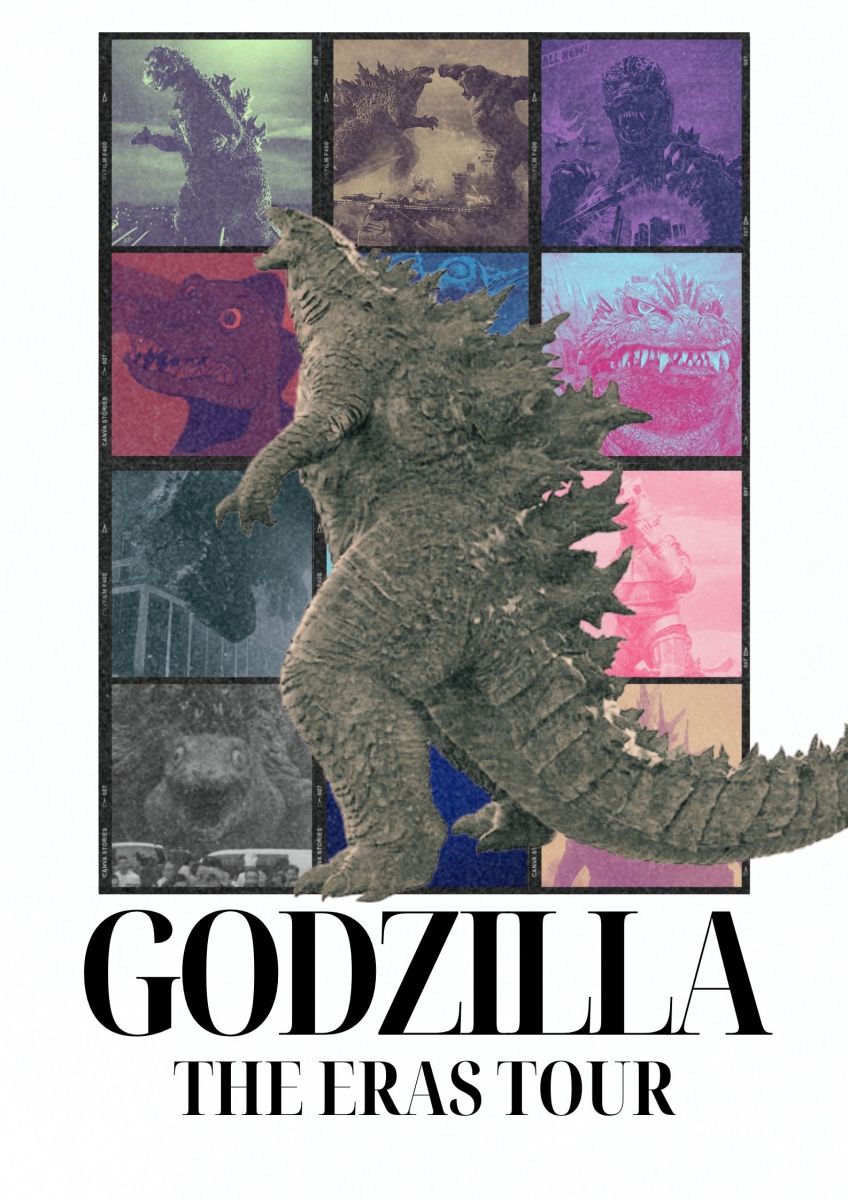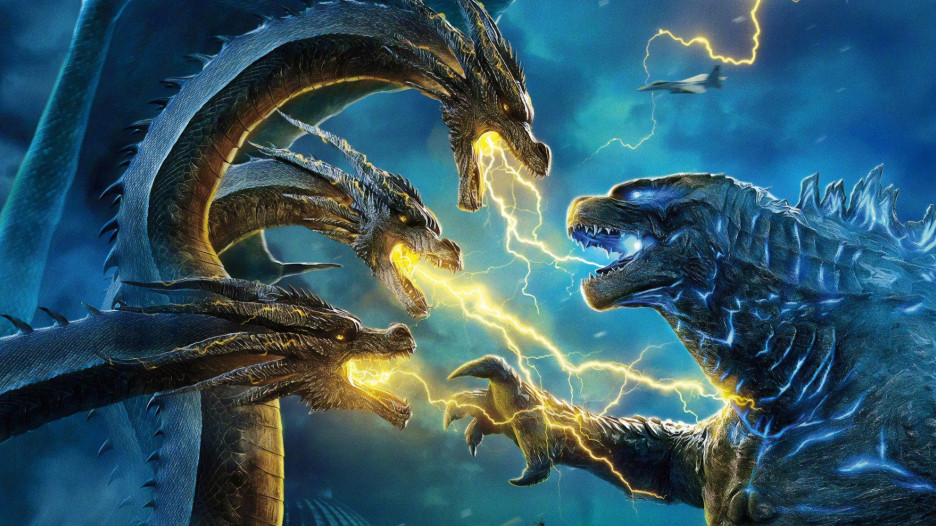On 3 November, a very special boy is celebrating his birthday. At only 70 years young, Godzilla is a legendary figure that first entered public consciousness in Ishirō Honda’s 1954 film Godzilla, and he hasn’t left since.
Whether you’re a massive kaiju-head or just tipping your scaly toes into the franchise for the first time, we’ve prepped a quick history lesson for you to aid your understanding of one of film history’s most famous monsters.
Godzilla has enough unique eras to rival Taylor Swift, so what better way to cover his story than outlining each one and the significant changes they brought to film production and cultural trends?
Chuck on this video in another tab to set the mood, and get to reading!
ScreenHub: Godzilla is storming into ACMI this spring for his 70th birthday bash
Godzilla quick facts
- Godzilla isn’t a lizard! He’s an underwater sea creature of some kind, which evolves into the Godzilla we know via nuclear radiation. His original name, Gojira, is a portmanteau of gorira (Japanese for gorilla) and kujira (Japanese for whale) – which is meant to evoke an image of a massive, bipedal beast.
- His famous roar, officially written as ‘Skreee-onk!’, was made by composer Akira Ifukube coating a glove in pine-tar resin and running it over the strings of a double bass. The same recording was used for decades.
- Japanese ‘suitmation’ actor Haruo Nakajima donned a rubber suit to play Godzilla in 12 consecutive films. Nakajima was also a blackbelt in judo, which informed his fight sequences.
- Godzilla has an adopted son, Minilla, who first appeared in the film Son of Godzilla. Godzilla also has another son, Godzilla Junior, and a nephew, Godzooky (but let it be known I rebuke Godzooky).
- The 1998 US film Godzilla was so widely panned that Toho, the company that own the rights to Godzilla, do not consider it an official part of the franchise. They also now call the beast in that film ‘Zilla’, lopping off the ‘God’ bit intentionally.
- Godzilla doesn’t just famously face off against King Kong. Some of his other foes (and friends) include Mothra the giant psychic moth, Hedorah the polluting alien, Anguirus and Rodan – both radioactive dinosaurs, King Ghidorah the three-headed dragon from space, Biollante the genetically modified plant, and Mechagodzilla (self explanatory). Phew!

Godzilla: The Eras Tour
Shōwa era (1954-1975)
What is Shōwa? This is the era that started it all. Named after the time when Emperor Shōwa still reigned over Japan, these 21 years cover the inception of Godzilla with the original 1954 film, all the way to 1975’s Terror of Mechagodzilla.
In this time, Godzilla films went from black and white to full colour, and from a quite sombre treatment of the beast as an allegory for nuclear war, to much sillier plots (involving aliens, cyborgs, and Interpol conspiracies).
This era is also well-known for pioneering techniques of suitmation that made it possible for actors to play creatures like Godzilla without passing out inside their rubber suits. To make the beast look gigantic, small scale models of Tokyo were built inside the studio for the actor to stomp around on.
Watch the trailer for 1954’s Godzilla:
Essential viewing of the Shōwa era:
- Godzilla (1954), the original and the best, this film remains a relevant metaphor for man’s hubris.
- Mothra vs Godzilla (1964), a nice allegory about protecting Japan’s native island culture.
- Ghidorah, the Three-Headed Monster (1964), the first time Godzilla became an antihero.
- All Monsters Attack (1969), a great display of suitmation acting.
- Godzilla vs Hedorah (1971), the film Takashi Yamazaki (Godzilla Minus One) wants to remake with modern technology.
- Godzilla vs Mechagodzilla (1974), a wacky technicolour delight that rivals Thunderbirds.
Godzilla (1954) is playing at various cinemas around Australia, beginning 31 October. You can check Flicks or JustWatch for movie times.
Heisei era (1984-1995)
What is Heisei? The Heisei era is named after Japan’s political Heisei era (Heisei being a word loosely meaning ‘to achieve world peace’), which actually started in 1989 with the ascension of Emperor Akihito. Nevertheless, this era of films starts with 1984’s The Return of Godzilla, directed by Koji Hashimoto. Starting to understand the naming convention? Good! Because it’s about to be thrown away completely.
This era is characterised by each of its films being in a continuous timeline, which was new for the Godzilla franchise at the time. The rubber suits were upgraded, as were other visual effects, and the storylines started to become more environmentally conscious. Genetic studies (particularly gene splicing) became a big focus of the films, informed by the real-life scientific advancements that were happening around the world.
Essential viewing of the Heisei era:
- The Return of Godzilla (1984), the film that brought Godzilla into a new era of SFX.
- Godzilla vs Biollante (1989), the film that introduces genetic splicing to create the kaiju Biollante.
- Godzilla vs King Ghidorah (1991), the film that tried to give the definitive Godzillla origin story.
TriStar (US)
What is TriStar? OK, it’s not technically official, but the 1998 Godzilla film released by TriStar Pictures was my first ever introduction to the King of the Monsters. So it counts. Plus, it’s the only Godzilla to have ever reproduced asexually and laid eggs.
Fun fact: Toho Pictures hated this film so much that in the 2004 flick Godzilla Final Wars, they introduced a Godzilla-like creature called ‘Zilla’ that they killed onscreen. Yeowch!
Millennium era (1999-2004)
What is Millennium? Forget the Y2K Bug, Godzilla is back for the new millennium and nothing can satisfy his hunger for skycrapers! This era is exactly as it says on the tin: Godzilla films made during the turn of the millennium.
In this era, the franchise went back to standalone films that did not follow a single continuity. These flicks, like a lot of movies of the time, have an obsession with leather, nu-metal, and testing the new limits of CGI.
Essential viewing of the Millenium era:
- Godzilla, Mothra and King Ghidorah: Giant Monsters All-Out Attack (2001)
- Godzilla Final Wars (2004), to see ’98 Zilla bite the dust in Sydney, Australia.
Monsterverse (US)
What is Monsterverse? Another Western take on Godzilla debuted in 2014, with Gareth Edwards directing and Hollywood stars Brian Cranston and Aaron Taylor Johnson leading the cast. This much more successful take on Japan’s scaly enemy-cum-ambassador launched the US era of Godzilla known as the ‘Monsterverse’.
Here, a lot of screen time is devoted to Godzilla going up against, or pairing up with, King Kong. Seeing as Kong is the US’s greatest movie monster, it makes sense. It’s unknown as to whether this improved US-Japan relations, however.
Essential viewing of the Monsterverse era:
- Godzilla (2014)
- Godzilla: King of the Monsters (2019)
- Godzilla vs Kong (2021)
Reiwa era (2016-)
What is Reiwa? Reiwa is the current and 232nd era of the official calendar of Japan. The term Reiwa comes from classical Japanese literature roughly means ‘order and harmony’. And that brings us to the current era of Godzilla!
Notably, these are the first ever Japanese films that did not use any suitmation for Godzilla, instead opting to fully animate the kaiju using CG.
In this time period, Godzilla has both become a symbol for government incompetence in the face of modern natural disasters and climate change. He’s also gone back to his 1950s post-war roots with Godzilla Minus One, which recently won an Academy Award for Best Visual Effects.
ScreenHub: Godzilla Minus One review: roar and emotional
Fun fact: Since 2016, Toho have established a ‘Godzilla Room’, which is essentially 14 people whose job is to study the previous Godzilla films and make sure that future movies are ‘brand consistent’. I wonder if they’re still hiring?
Essential viewing of the Reiwa era:
- Shin Godzilla (2016), the film co-directed by Hideaki Anno and Shinji Higuchi, who brought us Neon Genesis Evangelion.
- Godzilla Minus One (2023), the film about survivor’s guilt that won an Oscar.
Godzilla Day is on 3 November, with this year commemorating 70 years since the original film’s release.
From 31 October, ACMI are holding GODZILLAFEST, which includes movie marathons, trivia, and 3 free talks moderated by ScreenHub’s Silvi Vann-Wall.
Sugoi.Co have also organised screenings of the original Godzilla (1954) and Godzilla Minus One/Minus Color (2023) at select cinemas.
Check your local cinema’s website for further screening details.





